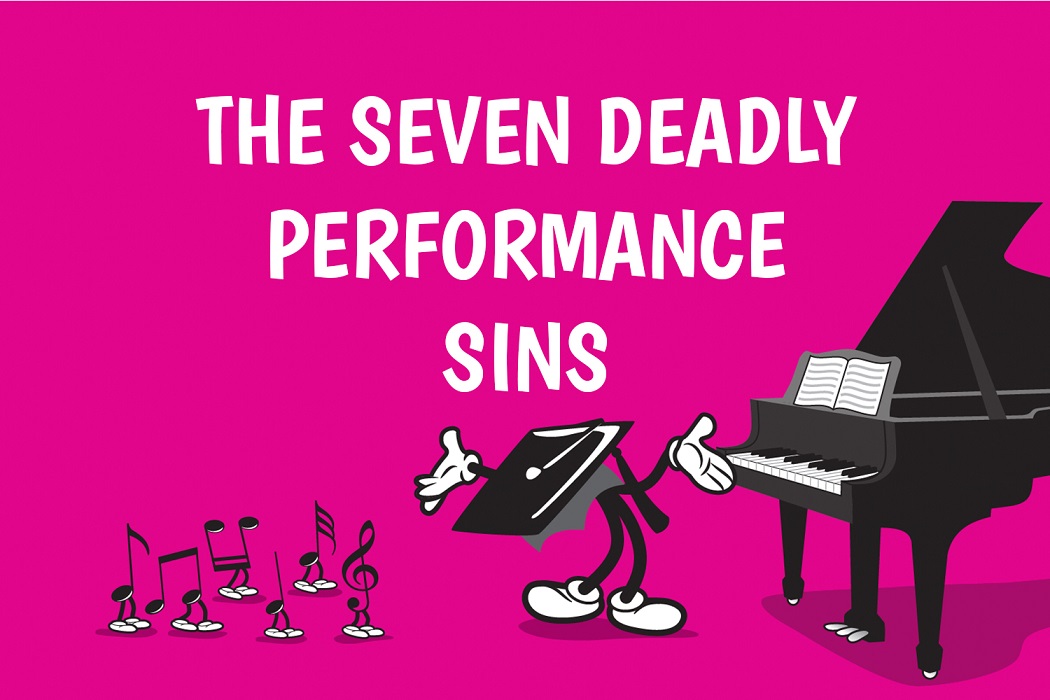The Seven Deadly Performance Sins

All sorts of things can go wrong in a performance. A cockroach can scuttle across your pedalling foot (this has happened to me). The music may fall off the stand (this has happened to me)….A blood blister on your cuticle may burst during a glissando (you guessed it, this has happened to me).
But no matter what happens, as they say, ‘the show must go on’. What is the reason for this? Why do you have to keep going no matter what?
Because it’s not about you. It’s about the audience, and their enjoyment of the music you are playing. As a performer, it’s your job to make sure their enjoyment is not interrupted.
So here are, in my opinion, the Seven Deadly Performance Sins:
1. Drawing attention to mistakes
If you say ‘oh sorry’ while you’re playing, or start again, or suddenly slow down during a performance, the audience gets distracted and it stops them enjoying the performance. No matter whether you play a wrong note, miss a dynamic, play a note out of tune (not easy to do on piano J) or forget to do a repeat, if you simply keep going, pretending it was all meant to be, 9 times out of 10 the audience will not know anything went wrong. Remember, we ignore mistakes in performance because a) it’s not practice time, and b) it’s not about you!
2. Correcting wrong notes
This is a more specific version of Performance Sin no. 1. Fixing a mistake doesn’t make the audience think ‘ah, THAT’s how it was supposed to go, I’m so glad I’ve heard it the right way now!’ Correcting wrong notes disrupts the rhythmic flow. An audience will usually not recognise an incorrect pitch, but they will always notice a disruption in rhythm.
3. Showing dissatisfaction
An audience can tell by your body language and facial expression if you are not happy with your performance, and it is very distracting! Don’t do things like frown, tut, slump your back, sigh or flop your arms/wrists in frustration. Have a poker face. All this counts both during AND after a performance. Be gracious. Do not apologise (especially to someone who is complimenting you on your playing). Better still, look like you are ENJOYING yourself!
4. Breaking the spell
During your performance, everyone in the audience is looking at you. But you can’t look at them. If you do, you will ‘break the spell’ of their listening reverie. An audience is not really looking at you – they are watching your involvement in the music, and if you consciously glance at something or someone in the audience, whether it be because you made an error, or because someone in the audience made a noise, you are disrupting your own involvement with the music. Even a scuttling cockroach has to be ignored J. Doing anything from Performance Sins 1-3 will also break the spell!
5. Starting too fast
Be aware of the power of adrenalin. I have witnessed many performers (myself included) derail themselves by starting too fast and finding the piece too difficult to play at that speed, which results in either slowing down (thus resulting in committing Performance Sin no. 1) or completely crashing! Create high-adrenalin situations for yourself during practice by performing for others in the house, or for your neighbours, or doing a ‘single take’ recording that you promise to send to your teacher. Practice the opening, and get used to controlling that adrenalin!
6. Altering the conditions
It is a very Deadly Performance Sin to do something on the day of the performance that you have not simulated in practice. Here are three common scenarios:
– Wearing high heels (if you only ever practise in flats)
– Playing from memory (when you’ve always had the music in front of you at home)
– Putting the music in front of you ‘just in case’ (if you’ve been used to playing it from memory)
Another way of committing this sin is to not have any performance run-throughs before the big day. If you are used to stopping and fixing, and taking long breaks between pieces, then during a performance you are ‘altering the conditions’ by making it the first time you don’t stop and fix and play the program right through. Part of performing is all about the way you handle mistakes, you have to practisehandling them! This means creating lots of different performance opportunities, so that you get good at working through all the things that may go wrong.
It’s bad enough that we pianists don’t get to perform on our own instruments and sit on our own piano stools. We have to adjust instantly to the new playing conditions. Don’t create even more stress for yourself by altering anything else on the day!
7. Not acknowledging audience
Your audience is there for you, and not acknowledging your listeners sets up a negative performance atmosphere. You should greet the audience with a smile or a nod, but most importantly and effectively with a bow. Bowing before and after a performance should be thought of as part of the performance itself (and should therefore be practiced!). Bowing is also polite; it is a performer’s way of saying ‘thank you for clapping for me’.
Your stage entrance is vital. Even if you don’t feel confident, it’s important to look as if you are! There was a recent study on the effect of confident stage entries on audiences. The results showed that people WANT to watch and listen to you more if you look confident! Engage the audience. Then thank them with a bow.
In conclusion: To be a good performer means to be able to communicate to an audience and carry them along a journey of musical enjoyment.
During practice time, the audience is not there. It is acceptable, in fact encouraged, to commit all of the above Performance Sins. That’s the idea of practice: we stop and fix, reflect, try again, go over (and over, and over!), analyse, criticise, slow down, correct… all with the goal in mind of being able to communicate flawlessly on the day.
Performing is the opposite! We must create, enjoy, trust, and above all keep going… even if we’re not quite communicating what we want, and it’s really not going so well at all.
Imagine you are an artist, and your painting is in a gallery. Imagine if, while someone was enjoying looking at it, you spotted a bit you didn’t like, and grabbed it off the wall in front of them and quickly scrubbed out and repainted a bit in the corner, and then put it back, expecting them to resume enjoying the painting as they were before. They wouldn’t be able to. Their enjoyment has been interrupted and now their attention will be drawn to the bit you scrubbed out. A better approach would be to let the person keep enjoying the painting… perhaps graciously accept their praise… and when they move on, decide how you want to make the painting better. You would then make those changes at home, not in the gallery J.
